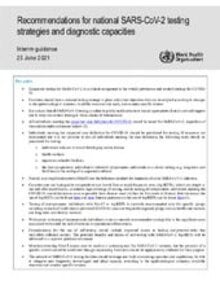
|
- Diagnostic testing for SARS-CoV-2 is a critical component to the overall prevention and control strategy for COVID-19.
- Countries should have a national testing strategy in place with clear objectives that can be adapted according to changes in the epidemiological situation, available resources and tools, and country specific context.
- It is critical that all SARS-CoV-2 testing is linked to public health actions to ensure appropriate clinical care and support and to carry out contact tracing to break chains of transmission.
- All individuals meeting the suspected case definition for COVID-19 should be tested for SARS-CoV-2, regardless of vaccination status or disease history (1).
- Individuals meeting the suspected case definition for COVID-19 should be prioritized for testing. If resources are constrained and it is not possible to test all individuals meeting the case definition, the following cases should be prioritized for testing:
- individuals who are at risk of developing severe disease
- health workers
- inpatients in health facilities
- the first symptomatic individual or subset of symptomatic individuals in a closed setting (e.g. long-term care facilities) in the setting of a suspected outbreak.
- Nucleic acid amplification tests (NAAT) are the reference standard for diagnosis of acute SARS-CoV-2 infection.
- Countries can use high quality antigen-detection lateral flow or rapid diagnostic tests (Ag-RDTs), which are simple to use and offer rapid results, to achieve high coverage of testing, ideally testing all symptomatic individuals meeting the COVID-19 case definition as soon as possible from disease onset (within the first week of illness). Information on the use of Ag-RDTs can be found here and here. Interim guidance on the use of Ag-RDTs can be found here (2).
- Testing of asymptomatic individuals with NAAT or Ag-RDTs is currently recommended only for specific groups including contacts of confirmed or probable COVID-19 cases and frequently exposed groups such as health care workers and long-term care facility workers.
- Widespread screening of asymptomatic individuals is not a currently recommended strategy due to the significant costs associated with it and the lack of data on its operational effectiveness.
- Considerations for the use of self-testing should include improved access to testing and potential risks that may affect outbreak control. The potential benefits and harms of self-testing with SARS-CoV-2 Ag-RDTs will be addressed in a separate guidance document.
- Mutation-detecting NAAT assays may be used as a screening tool for SARS-CoV-2 variants, but the presence of a specific variant should be confirmed through sequencing. Such tests should be appropriately validated for their purpose.
- The network of SARS-CoV-2 testing facilities should leverage and build on existing capacities and capabilities, be able to integrate new diagnostic technologies and adapt capacity according to the epidemiological situation, available resources and country specific context.
|

